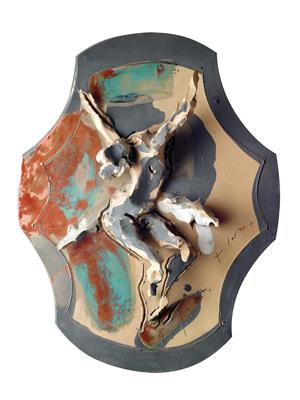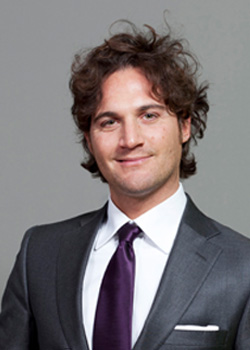Lucio Fontana *

(Rosario di Santa Fe, Argentina 1899–1968 Comabbio)
Crocifissione, 1957–58, signed, painted and glazed terracotta, 40 x 32 x 6.5 cm, framed
The work is registered in the Archivio of the Fondazione Lucio Fontana, Milan and is accompanied by a photo certificate
Provenance:
Pancera Collection, Milan
Galleria Tonelli, Milan
European Private Collection
I am looking for something else. During my long stay in the laboratories in Sèvres, I researched and studied form. I continued to model, as in my studio, figures and metamorphoses that weighed 100 kilos,
I painted them with strong colours.
My sculptural form from the first to the last models is never dissociated
from the colour. My sculptures were always polychrome.
I coloured the cast, I coloured the terracotta.
Lucio Fontana
‚I sculpted my first ceramic in Argentina in 1926: the “Charleston Dancer” bought by the gallery of modern art in Rosario, Santa Fe. It was, however, only in 1936 that I became properly active in this field with the production of around fifty pieces: seaweed, butterflies, crocodiles, lobsters, an entire, petrified, gleaming aquarium. The material was attractive;
I could shape a seabed, a statue or a lock of hair and impose a pure and compact colour which amalgamated in the fire. Fire was a sort of intermediary: it perpetuated form and colour. After the aquarium, I sculpted busts, masks, metamorphoses; my women with their golden faces toured Italian galleries. The material was shaken to the core but stable. Critics referred to it as ceramics. I called it sculpture.‘
Lucio Fontana
Fontana was involved in avant-garde artistic research in Milan as early as the 1930s. His research was characterised by experimentation, yet also marked by some structural constants.
In these years, however, Fontana proved himself to be more innovative than his contemporaries in his desire to communicate with architecture, to “act spatially” (Crispolti). His terracotta works suggest a predisposition towards a new material flexibility. His chromaticism, which extends from coarse, stoneware tones to lighter, glazed colours, becomes the instrument capable of freeing material from its stasis.
Time spent at ceramicist Tullio Mazzotti’s studio in Albissola between 1935 and 1936 was a turning point in Fontana’s research. Here the artist “connects the avant-garde principles from the beginning of the century, of which his friend Tullio is the close custodian, with new, contemporary necessities, and as early as 1937 created new figures, shapes, ceramics which pushed way beyond simple decorative intent, vibrating instead with a new expressive and expressionist touch”.
Fontana left Europe to return to Argentina at the beginning of 1940, and would remain there until 1947. His Argentine stay incubated the product of the immediate post-war period; on his return to Italy, Fontana brought with him the innovations developed in the Manifesto Blanco, the foundations of what would later become Spatialism, as well as a new syncretism in his sculpture: “it was the founding themes of Spatialism, in particular the holes, which would literally incise and cross the first abstract ceramics to be created at the threshold of the Fifties. On the one hand Fontana crosses, alters, rubs into the clay tablets, tracing both a spatially defined sign, as well as boring into the surface in a serrated rhythm, following the more recent dictates of his personal, Spatialist spirit. On the other hand, beginning always with a tile, a terracotta surface, he casts a nucleus of material onto the surface and […] creates and delineates in the freedom of the contrast between material, colour, gesture, and space a figurative world which exists in the ambiguity of a new potential identity”.
The series created by the artist in the post-war period consciously mixes the sacred and the profane, interpreting popular themes in an original manner: “he now addresses the production of crucifixes, unstable and suspended in their abyssal, stellar material, through a systematically stylised, evocative representation, immersed in the struggle between the darkness symbolising pain and the light generated by the mystical luminosity of gold. It is the birth of a type of sculpture that Fontana would define as Baroque. This quintessentially vital term was used by Fontana in exactly this ‘storminess’, in a creative sense of space, regarding that unstoppable, pure, compelling instability of Wölfflinian origin”.
L. M. Barbero, La scultura come un brivido, 2015
Specialist: Alessandro Rizzi
 Alessandro Rizzi
Alessandro Rizzi
+39-02-303 52 41
alessandro.rizzi@dorotheum.it
05.06.2019 - 17:00
- Realized price: **
-
EUR 174,100.-
- Estimate:
-
EUR 70,000.- to EUR 100,000.-
Lucio Fontana *
(Rosario di Santa Fe, Argentina 1899–1968 Comabbio)
Crocifissione, 1957–58, signed, painted and glazed terracotta, 40 x 32 x 6.5 cm, framed
The work is registered in the Archivio of the Fondazione Lucio Fontana, Milan and is accompanied by a photo certificate
Provenance:
Pancera Collection, Milan
Galleria Tonelli, Milan
European Private Collection
I am looking for something else. During my long stay in the laboratories in Sèvres, I researched and studied form. I continued to model, as in my studio, figures and metamorphoses that weighed 100 kilos,
I painted them with strong colours.
My sculptural form from the first to the last models is never dissociated
from the colour. My sculptures were always polychrome.
I coloured the cast, I coloured the terracotta.
Lucio Fontana
‚I sculpted my first ceramic in Argentina in 1926: the “Charleston Dancer” bought by the gallery of modern art in Rosario, Santa Fe. It was, however, only in 1936 that I became properly active in this field with the production of around fifty pieces: seaweed, butterflies, crocodiles, lobsters, an entire, petrified, gleaming aquarium. The material was attractive;
I could shape a seabed, a statue or a lock of hair and impose a pure and compact colour which amalgamated in the fire. Fire was a sort of intermediary: it perpetuated form and colour. After the aquarium, I sculpted busts, masks, metamorphoses; my women with their golden faces toured Italian galleries. The material was shaken to the core but stable. Critics referred to it as ceramics. I called it sculpture.‘
Lucio Fontana
Fontana was involved in avant-garde artistic research in Milan as early as the 1930s. His research was characterised by experimentation, yet also marked by some structural constants.
In these years, however, Fontana proved himself to be more innovative than his contemporaries in his desire to communicate with architecture, to “act spatially” (Crispolti). His terracotta works suggest a predisposition towards a new material flexibility. His chromaticism, which extends from coarse, stoneware tones to lighter, glazed colours, becomes the instrument capable of freeing material from its stasis.
Time spent at ceramicist Tullio Mazzotti’s studio in Albissola between 1935 and 1936 was a turning point in Fontana’s research. Here the artist “connects the avant-garde principles from the beginning of the century, of which his friend Tullio is the close custodian, with new, contemporary necessities, and as early as 1937 created new figures, shapes, ceramics which pushed way beyond simple decorative intent, vibrating instead with a new expressive and expressionist touch”.
Fontana left Europe to return to Argentina at the beginning of 1940, and would remain there until 1947. His Argentine stay incubated the product of the immediate post-war period; on his return to Italy, Fontana brought with him the innovations developed in the Manifesto Blanco, the foundations of what would later become Spatialism, as well as a new syncretism in his sculpture: “it was the founding themes of Spatialism, in particular the holes, which would literally incise and cross the first abstract ceramics to be created at the threshold of the Fifties. On the one hand Fontana crosses, alters, rubs into the clay tablets, tracing both a spatially defined sign, as well as boring into the surface in a serrated rhythm, following the more recent dictates of his personal, Spatialist spirit. On the other hand, beginning always with a tile, a terracotta surface, he casts a nucleus of material onto the surface and […] creates and delineates in the freedom of the contrast between material, colour, gesture, and space a figurative world which exists in the ambiguity of a new potential identity”.
The series created by the artist in the post-war period consciously mixes the sacred and the profane, interpreting popular themes in an original manner: “he now addresses the production of crucifixes, unstable and suspended in their abyssal, stellar material, through a systematically stylised, evocative representation, immersed in the struggle between the darkness symbolising pain and the light generated by the mystical luminosity of gold. It is the birth of a type of sculpture that Fontana would define as Baroque. This quintessentially vital term was used by Fontana in exactly this ‘storminess’, in a creative sense of space, regarding that unstoppable, pure, compelling instability of Wölfflinian origin”.
L. M. Barbero, La scultura come un brivido, 2015
Specialist: Alessandro Rizzi
 Alessandro Rizzi
Alessandro Rizzi
+39-02-303 52 41
alessandro.rizzi@dorotheum.it
|
Buyers hotline
Mon.-Fri.: 10.00am - 5.00pm
kundendienst@dorotheum.at +43 1 515 60 200 |
| Auction: | Post-War and Contemporary Art I |
| Auction type: | Saleroom auction |
| Date: | 05.06.2019 - 17:00 |
| Location: | Vienna | Palais Dorotheum |
| Exhibition: | 25.05. - 05.06.2019 |
** Purchase price incl. charges and taxes
It is not possible to turn in online buying orders anymore. The auction is in preparation or has been executed already.
More objects by this artist
-

Estimate:
EUR 3,000.- to EUR 5,000.-
